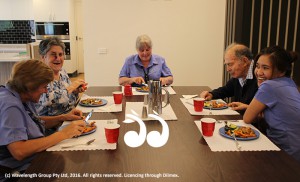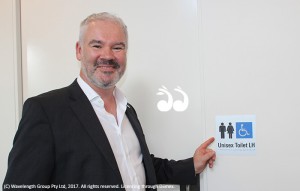Expert Eye for Care
SOME signs may seem obvious, but as Associate Professor Colm Cunningham pointed out when he visited Strathearn last week, a person with dementia may see things differently.
Stick figures to represent male and female toilets only came into common use 50 years ago, so patients in their 70’s with dementia may not recognise a toilet sign, explained Assoc Prof Colm Cunningham, director of dementia care, Hammond Care.
“Dementia patients can also lose their ability to read, so having the word ‘toilet’ may not help either, but if we put a picture of a toilet, they will understand,” said Assoc Prof Cunningham.
Assoc Prof Cunningham, is also a visiting fellow in dementia design and practice at the University of Edinburgh School of Health and last week he cast his expert eye over the Strathearn facilities.
“While this is a super brand new building there are a few things we’ve picked up on, for example the public toilet signs and also the height of signage for old people,” said Assoc Prof Cunningham.
“There is a sign which is two metres from the floor but for an older person who has a spine which is shortening it means their eye level is lower and their eye muscles weaken so it restricts their field of vision, so instead of hanging signs 2 metres high we put signs 1.2 metres from the floor so it is in their range of vision,” he said.
“The memory boxes near the doors in here are great, so that people can recognise objects beside their door and know it is their room, I’ve even seen one company in the UK which went so far as to print big posters the size of the door that go on the door and they reproduce the front door of the door that was most familiar to them,” he said.

Staff and residents enjoying lunch together: Margaret Sweetnam, Jean Blake, Libby Newell, Peter McKenzie and Vanessa Cabredo.
Prof Cunningham also stressed that caring for dementia patients was not just about signage and the physical environment, but knowing the importance of staff knowing each person well.
“It’s important to know the person, know their story and then you’ll find solutions,” said Assoc Prof Cunningham.
“At 7 o’clock in the morning our phones start to get busy with our 1800 number because people would start ringing in because they are being aggressive, but in 60 percent of cases we actually find it is a pain related issue,” he said.
“A woman in her 70’s typically has arthritic joint problems and if you move an arthritic joint after being lying down all night they might well tell you to get away or smack you, whereas things can start to get classed as a behavioural issue, so we try and shift people’s thinking and try to understand what is going on with the patient,” he said.
“I grew up in Northern Ireland so if I become a dementia patient I will probably react badly to alarms going off and when I was a boy my mother would push us to the floor if there was a loud noise; so any loud noises I’ll react to and that has the potential to come back when I am older with ‘challenging behaviour’,” he laughed.
“There was a sheep farmer who missed his kelpie terribly and the home would not allow a dog to come in, so they took a stuffed dog in and it actually relaxed more and he started to become more interactive with people; and while that was good the best thing would be to get a real dog there for him; but the most challenging thing about having a dog in a facility is the weight the dog puts on because everybody wants to feed it,” he said.
“It’s important for staff to slow down, pay attention and not be too task focused in their care,” he said.
While Prof Cunningham described the new facility as a pleasure with good access to the outdoors, they plan to do a sound study at the older Strathearn facility.
“One of the reasons you might move away from a spot in a café may be because the noise of people around you is too much and you are unable to hear and often in facilities there are four different types of noise coming at you from different angles and then the residents start to wander, because they actually want to find a quiet space rather than it being wandering behaviour,” said Assoc Prof Cunningham.
“We want to work out how we can bring that down that noise and make those spaces more comfortable,” he said.
“The light is another important issue, older people need double the level of illumination, so educating staff to adjust light levels to what the residents need,” Colm Cunningham said.
 scone.com.au
scone.com.au